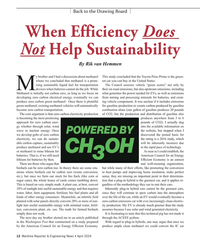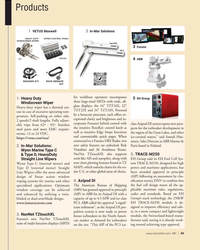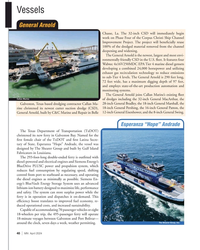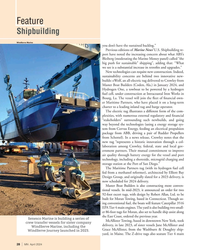Fuel Cells
-
- Fuel Cells: industry examines options in race to zero emissions Marine News, Mar 2019 #28
A maritime consortium, including ABS and Sandia National Laboratories, recently proved the viability of a hydrogen fuel cell ferry designed for operations in the environmentally sensitive San Francisco Bay area.
The IMO’s mandate to cap the sulfur content in marine fuel at the start of next year may be the biggest regulatory change in shipping since the requirement for double hulls, but the challenge will fade in comparison to its future goals to reduce green-house gases (GHG).A year ago (April 2018), the IMO agreed to a preliminary strategy that targeted a minimum 40% reduction in CO2 emissions on a cargo-tonne mile basis by 2030, and a 50% reduction in GHG emissions from shipping by 2050. To support and inform that goal, the mandatory collection of emissions data from ships started in January. The IMO’s final strategy will be unveiled in 2023. In the interim, it is committed to release its fourth GHG study, and to analyze and report the findings from three years of having collected data on the industry’s emissions.
The mandatory global targets to reduce the emissions from shipping are the most ambitious yet: they will require measures that combine improvements in ship design; the creation of new fuels and alternative forms of propulsion; operational changes; and the application of digital technology. Because those goals are unlikely to be met without the development of new technology, industry and governments will need to expand the resources they make available for research and development.
A technology with potential
One area of promise for energy generation onboard ships is fuel cells. Fuel cells are presently used in a variety of land applications, such as to provide power in remote areas, as well as for industrial, residential and commercial buildings. Energy from hydrogen fuel cells, in particular, is already used in land-based transport vehicles, such as municipal buses, trains and heavy-duty trucks, as well as for industrial equipment such as forklifts.While submarines have been built recently with hybrid propulsion units using hydrogen fuels cells, its use in the commercial shipping sector largely has been limited to auxiliary purposes: fuel cells can provide shipboard heat and power – including ‘hotel’ power, such as that required on cruise ships – and ‘cold ironing’, providing an alternative shoreside power source that allows ships to shut down their engines while at dock, lessening their emissions output.
Additionally, there has been a lot of research and prototyping in the maritime sector to investigate applications on small passenger ferries and other short-sea vessels. ABS, in partnership with Sandia National Laboratories, recently confirmed the feasibility of high-speed, hydrogen-fueled ferries for use in the San Francisco Bay area. Separately, Norway late last year provided the funding for construction of a hydrogen-powered high-speed ferry and a short-sea freighter.
Potential, and Challenges
Hydrogen fuel cells technology has the potential to offer reliable, long-range power on an industrial scale, with relatively quick refueling when compared to the emerging battery-powered options. Hydrogen itself has higher energy density than batteries, potentially making fuel-cell systems more practical for operators looking to replace or supplement traditional bunker-fuelled propulsion units.However, sourcing of hydrogen can be energy intensive. Without the incorporation of renewably generated hydrogen, the net impact on GHG gas for hydrogen produced by methane or similar processes is negligible. Also, adopting hydrogen as a deepsea marine fuel is not without challenges, even before safety factors are considered.
It is important to compare the energy density of different energy sources – including fuel cells – to better understand how they need to mature before they will be suitable for global shipping, where the carriage of cargo is the main focus. In general, fuel cell systems require less maintenance (potentially offering lower maintenance costs) and long service lives. They also generate less noise than present heavy oil power plants, contributing to a more comfortable work environment for the crew and less disruption for the surrounding marine life.
The suitability of fuel cell systems for hybrid propulsion solutions – coupled with diesel – has an extensive track record. But perhaps most importantly for proactive owners looking for a path to IMO emissions compliance in 2030 and 2050, hydrogen fuel cell systems would generate zero GHGs; their only by-product from energy generation is water. Another key challenge will be for the marine industry to develop a hydrogen-distribution system that is capable of producing and distributing the significant quantities required for a global network of large ships.
The refineries are adjusting their production processes to accommodate increases in demand as alternate fuels gain popularity, but the supply networks will need to mature before the marine industry will feel confident enough to widely adopt power systems that utilize fuel cells. As a power generation technology, fuel cells are comparatively mature. Shipowners may want to look at the technology as something more than a ‘future fuel’ and instead recognize its present benefits to the marine industry as they act to reduce the carbon footprints of their fleets and steer towards a more sustainable future.
How fuel cell systems work
A fuel cell is a device that converts the chemical energy from a fuel into electricity via an electrochemical reaction of the fuel with oxygen, or other oxidizing agents. They differ from batteries in that fuel cells require a continuous source of fuel and oxygen (usually from the air) to sustain the chemical reaction, whereas the availability of energy from a battery is fixed by the amount of energy it has stored. Fuel cells can produce electricity continuously as long as fuel and oxygen are supplied to them.There are many types of designs for fuel cells. Most consist of an anode, cathode and an electrolyte that allows positively charged hydrogen ions (known as protons) to move from the anode to the cathode side of the fuel cell.
Safety and emerging regulation
There are currently no IMO regulations to provide prescriptive requirements for fuel cell installations; they are in the process of being developed. These developments are being reviewed as an extension of low flash point fuel requirements. Safety issues pertaining to gaseous fuels such as hydrogen, methane and other ‘lighter-than-air’ fuels, or propane (which is heavier than air), need special arrangements for ventilation to prevent the formation of the hazardous areas that are prone to explosion.For many fuel cells, the non-hydrogen supply is externally reformed to hydrogen and other byproducts prior to introduction into the fuel cell. So the hydrogen portion of the fuel system – from the reformer to the fuel cell - needs careful design consideration and features.
Safety and operational reviews of fuel cell installations for marine and offshore assets primarily rely on risk-based studies in combination with IMO vessel regulations, IACS requirements, the applicable industrial standards and Rules or Guides based on the particular design and configuration of the fuel cell system.The International Code of Safety for Ships Using Gases or Other Low-Flashpoint Fuels, known as the IGF Code, is currently being revised to address the requirements for fuel cell systems; it is anticipated by industry that this will assist with the present safety challenges.
To support and promote a safer and more sustainable practice as the industry increasingly adopts fuel cell systems, ABS will soon publish a Fuel Cell Guide on marine applications for the technology, including propulsion and other auxiliary uses. It will offer a structured approach to the application of fuel cell systems in a format that is flexible enough to include other gaseous fuels and any future technological upgrades.Shipowners are facing some challenging environmental decisions as more stringent regulations shift the course of their industry towards a more sustainable future: a 0.5% sulphur cap on fuel by the end of this year; a minimum 40% reduction in CO2 emissions from ships by 2030; a 50% reduction in GHG output by 2050; and potentially even more ambitious goals set by regional and national governments.
It may be time for them to start to consider what if any role fuel cells could play in providing a solution.Mr. Carlucci is currently the ABS Manager for Machinery, Electrical and Controls Technology. Since joining ABS in 2008 Carlucci has held several senior roles in asset integrity management, life cycle risk and reliability, design and plan review, and product and service development. With extensive experience in the marine and offshore industries, Carlucci’s expertise includes: hybrid power applications, ship systems operations and maintenance, systems designs, risk and reliability analysis (FMEA, RCM), and condition/performance monitoring. He served in the U.S. Navy as a Nuclear trained Surface Warfare Officer. Mr. Carlucci received his Bachelors of Science in Mechanical Engineering from Duke University and a Master’s in Business Administration from University of Houston.
This article first appeared in the March 2019 print edition of MarineNews magazine.
-
- (Fuel) Cells of Endeavor Maritime Reporter, Mar 2001 #10
propulsion. German propensity for front-line advance in engineering is also implicit in the nomination of Siemens PEM (proton exchange membrane) fuel cells as part of the integrated propulsion arrangements for the navy's new 212-class submarines. Now, classification society Germanischer Lloyd has
-
- (Fuel) Cells of Endeavor Maritime Reporter, Sep 2004 #50
the noxious emissions produced by internal combustion engines, plus quiet, vibration-free running and high thermal efficiency are characteristics of fuel cells that are of interest to sectors of the marine market. In the meantime, Howaldtswerke- Deutsche Werft (HDW) has been commercially vindicated in
-
- New Technology Has Promising Maritime Applications Maritime Reporter, Sep 2002 #52
the benefits of using its fuel to power ships and facilities in ports. The project is designed to meet CCDOTT goals for zero emissions from fuel cells, and the contract award comes as many operators in U.S. ports are facing potential fines for being well in excess of Environmental Protection
-
- Cruise Ships & Eco-Trends in Energy Transition Maritime Reporter, Feb 2018 #44
on shore, and I think that the Tesla Revolution is coming to the Seas. When it does, we are confident that we will be in front when that happens.” Fuel Cells The use of fuel cells as an eco-friendly ship propulsion has also received a lot of attention from organizations such as Carnival and Royal Caribbean
-
- Marine Fuels: Unmasking Gas Marine News, Nov 2017 #42
full electric configurations. One of the newest alternative fuels and propulsion systems for maritime consideration is the fitting of hydrogen powered fuel cells. Arguments can be made for each, but how do you know if such a system is a good fit for your vessel and operating patterns? The many and varied
-
- Interview: Eddie Brown, Cummins' Director of Business Development, Marine Marine News, Jul 2020 #12
for Cummins’ hydrogen fuel cell business and will be the primary channel for development and new hydrogen-related product launches.Hydrogenics’ Fuel Cells Power Modules can be used for both auxiliary and propulsion power. With on-board hydrogen storage, fuel cells can produce power for the length of
-
- The Shipping Industry Embraces Battery Power Maritime Reporter, May 2021 #32
are looking at transitions away from fossil fuels. Among the myriad of alternatives are lithium ion batteries and some early forays into hydrogen fuel cells.To date, large batteries are used on short runs, mainly as an auxiliary power source in conjunction with traditional fossil fuels, with benefits
-
- Propulsion Stays Firmly Based on Diesel Engines Maritime Reporter, May 2003 #54
. In the past couple of years, the discussion about alternative forms of propulsion increased, especially on the subject of gas turbines and hydrogen fuel cells (FC). Ships need a propulsion system that can provide reliable transportation from point A to point B within an acceptable period of time - with
-
- Siemens To Supply Fuel Cell Technology Maritime Reporter, Mar 2001 #19
2005 and 2008. The $35.5 million contract features propulsion systems that will include Permasyn permanent- field electric motors and PEM Fuel cells (polymer electrolyte membrane) as power sources. Howaldtswerke- Deutsche Werft (HDW) has been granted a contract to supply the Greek Navy with
-
- Hydrogen as Fuel: Possibilities, But… Marine News, Jul 2022 #32
through but not the negatively charged electrons which must flow around the membrane, forming an electrical current.If pure hydrogen is used as a fuel, fuel cells emit only heat and water, eliminating concerns about air pollutants or greenhouse gases.Sandia concluded that H generation can reduce maritime related
-
- Alternative Ferry Propulsion Systems: A Case Study Marine News, Mar 2017 #24
short time at the terminal. EBDG has also been working with Sandia National Laboratories on the feasibility of fuel cell propulsion for vessels. The fuel cells are existing commercial units that use hydrogen as a fuel and are packaged in cabinets, much like the battery racks, with an output of 120 kW per
-
 )
March 2024 - Marine Technology Reporter page: 45
)
March 2024 - Marine Technology Reporter page: 45and the ? exibility for ship or port-to- port mission deployments. Cellula’s Solus-LR and Solus- XR platforms will be equipped with Cellula’s hydrogen fuel cell technology, supporting sustainable, long duration operations with zero carbon emissions • Teledyne Marine Acquires Valeport Teledyne Marine agreed
-
 )
March 2024 - Marine Technology Reporter page: 39
)
March 2024 - Marine Technology Reporter page: 39Photo courtesy Global Ocean Design Figure 7 A 35Ah AGM lead-acid battery is tested using the West Mountain Radio CBA to show the effect of simply ? lling the battery voids with mineral oil as a compensating ? uid. The CBA is programmed to cut-off at a voltage of 10.50v. The top line (red) shows the
-
 )
March 2024 - Marine Technology Reporter page: 38
)
March 2024 - Marine Technology Reporter page: 38LANDER LAB #10 Photo courtesy West Mountain Radio Photo courtesy of Clarios/AutoBatteries.com Figure 6 The West Mountain Radio Computerized Battery Analyzer (CBA V) attaches to a Figure 5 laptop by a USB-B cable, and to a battery by Powerpole® Connectors. Exploded view of an AGM lead-acid battery.
-
 )
March 2024 - Marine Technology Reporter page: 37
)
March 2024 - Marine Technology Reporter page: 37miscible barrier ? uid heavier than seawater (sg=1.026) and lighter than the battery electrolyte (sg=1.265). The original cell vent cap was screwed into the top of the riser pipe to vent the gases associated with charging. Wires were soldered to the lead (Pb) posts. The lead-acid battery was additionall
-
 )
March 2024 - Marine Technology Reporter page: 36
)
March 2024 - Marine Technology Reporter page: 36LANDER LAB #10 Of special interest for marine applications, LiPo batteries are Shipping any kind of lithium battery can be a challenge, and offered in a “pouch” design, with a soft, ? at body. The pouch IATA regs vary with the batteries inside or outside an instru- is vacuum-sealed, with all voids ?
-
 )
March 2024 - Marine Technology Reporter page: 35
)
March 2024 - Marine Technology Reporter page: 35Figure 1 A self-righting vehicle design with buoyancy high and weight low, WHOI’s SeaBED AUV captures the attention of a pair of curious Antarctic penguins as it is deployed from the British research vessel James Clark Ross. Vehicle designers allowed for temperature reduction of battery capacity. Recharge
-
 )
March 2024 - Marine Technology Reporter page: 34
)
March 2024 - Marine Technology Reporter page: 34LANDER LAB #10 BATTERY PACKS, CHARGING, AND CAPACITY TESTING Photo Credit: Hanumant Singh / Woods Hole Oceanographic Institution. By Kevin Hardy, Global Ocean Design LLC n ocean lander has many strengths including that produces the current is irreversible. Examples include ? exibility of deployment
-
 )
March 2024 - Marine Technology Reporter page: 18
)
March 2024 - Marine Technology Reporter page: 18TECH FEATURE IMR There are also weaknesses in terms of accuracy because of FiGS Operations and Bene? ts signal noise and the ability to detect small ? eld gradients. In Conventional approaches to evaluating cathodic protection this process there is a risk that possible issues like coating (CP)
-
 )
March 2024 - Marine Technology Reporter page: 17
)
March 2024 - Marine Technology Reporter page: 17• Integrity assessment, and otherwise covered, e.g., by rock dump. As for depletion of • Mitigation, intervention and repair. sacri? cial anodes, this can be dif? cult or even impossible to Selecting the best method for collecting the data these work- estimate due to poor visibility, the presence of
-
 )
April 2024 - Maritime Reporter and Engineering News page: 43
)
April 2024 - Maritime Reporter and Engineering News page: 43for the decarbonization. New energy saving devices, alterna- design, planning and testing of ships, “I don't say that crews must be soft- tive fuels, carbon capture, batteries and and a regulatory framework which takes ware engineers, but there is no going fuel cell power will all provide critical
-
 )
April 2024 - Maritime Reporter and Engineering News page: 39
)
April 2024 - Maritime Reporter and Engineering News page: 39at Fjord Base in Florø, Norway. Azane’s efforts to make low-emission ammonia a common The planned terminal consists of a ? oating stationary barge fuel for shipping. With ammonia’s potential to fully decar- with a capacity of 1000 cubic meters, or 650 tons, of am- bonize the maritime sector, the companies
-
 )
April 2024 - Maritime Reporter and Engineering News page: 38
)
April 2024 - Maritime Reporter and Engineering News page: 38. Images courtesy Consulmar Crowley's New LNG Containerships Carbon Capture @ Sea Crowley shared ? rst renderings and the names of its four new dual fuel lique? ed natural gas (LNG)-powered containerships: Quetzal, Copan, Tiscapa and Torogoz. The 1,400 TEU ves- sels were ordered in 2022 by Singapore-based
-
 )
April 2024 - Maritime Reporter and Engineering News page: 35
)
April 2024 - Maritime Reporter and Engineering News page: 35. One of the most important is the familiar- for a new maritime training center in Finland that will have ization of the crew with new and emerging fuels and technol- two engine room simulators along with two large and three ogy. For example, the industry has well-established experience medium sized
-
 )
April 2024 - Maritime Reporter and Engineering News page: 32
)
April 2024 - Maritime Reporter and Engineering News page: 32(in yellow). Images courtesy of Mammoet requirement for the development of these cranes, particularly ling area. This would result in a major time and fuel saving. in ? oating offshore wind,” says Adrian Green, Engineering & For ? oating projects, it could reduce project installation time Contracts
-
 )
April 2024 - Maritime Reporter and Engineering News page: 28
)
April 2024 - Maritime Reporter and Engineering News page: 28expeditionary transfer docks (ESDs) and four expeditionary sea base ships. We also have two offshore petro- leum distribution system ships that help move fuel ashore. Another ten preposition ships support the Army and Air Force. It should be pointed out that we can build adaptive force packages to be placed
-
 )
April 2024 - Maritime Reporter and Engineering News page: 27
)
April 2024 - Maritime Reporter and Engineering News page: 27that it is and Clark class dry cargo and ammunition ships that deliver will help us to retain them. Unfortunately, we can’t guaran- ammo, food, parts and fuel. We have two big fast combat sup- tee everyone their choice of ship assignment because we just port ships (T-AOEs), that are fast enough to keep up
-
 )
April 2024 - Maritime Reporter and Engineering News page: 18
)
April 2024 - Maritime Reporter and Engineering News page: 18SOV emissions reduction measures, more than 20 active or under and three Tier 1 CSOVs in construction for the comparatively construction vessels feature fuel ? exibility through dual fuel near shore Taiwanese market, which is also actively served by engines and (space for) a bunkering system. Currently
-
 )
April 2024 - Maritime Reporter and Engineering News page: 16
)
April 2024 - Maritime Reporter and Engineering News page: 16. A typical offshore wind markets. SOV is diesel electric and increasingly includes dual ¦Tier 3: Generally, oil & gas tonnage (MPSVs, PSVs, fuel ? exibility and battery energy storage systems. etc.) with temporary gangway, serving oil & gas and CSOV: Commissioning service operations vessel
-
 )
April 2024 - Maritime Reporter and Engineering News page: 13
)
April 2024 - Maritime Reporter and Engineering News page: 13promise of eventually being carbon zero. Electrify everything.4. Don’t get me wrong, I am an ef? ciency freak, and I strongly Avoid building new carbon fuel IC equipment at all cost.5. support the inherent favorable bias to smaller cars in the ACEEE Ef? ciency increases are a great way to speed up 6
-
 )
April 2024 - Maritime Reporter and Engineering News page: 12
)
April 2024 - Maritime Reporter and Engineering News page: 12that the Toyota Prius Prime is the green- where we concluded that methanol is a prom- est car you can buy in the United States. ising sustainable liquid fuel for transportation The Council assesses vehicle “green scores” not only by Mdevices when batteries cannot do the job. While their on-road emissions
-
 )
April 2024 - Marine News page: 43
)
April 2024 - Marine News page: 43Marine Type C NavNet TZtouchXL also supports & Type D, HeavyDuty 5. TRACE-M250 tools like AIS and autopilot, along with EH Group said its EH Fuel Cell Sys- Straight Line Wipers Wynn Type C (internal motor) and new chart plotting features found in TZ tem TRACE-M250, designed for high power
-
 )
April 2024 - Marine News page: 40
)
April 2024 - Marine News page: 40ferry is out? tted with diesel-powered and electrical engines and Siemens Energy’s BlueDrive PLUSC power and propulsion system, which reduces fuel consumption by regulating speed, shifting control from port to starboard as necessary, and operating the diesel engines as minimally as possible.
-
 )
April 2024 - Marine News page: 28
)
April 2024 - Marine News page: 28an all-electric tug delivered to Crowley from Master Boat Builders (Coden, Ala.) in January 2024, and Hydrogen One, a towboat to be powered by a hydrogen fuel cell, under construction at Intracoastal Iron Works in Bourg, La. The vessel will join the ? eet of ? nancial own- er Maritime Partners, who have
-
 )
February 2024 - Maritime Reporter and Engineering News page: 44
)
February 2024 - Maritime Reporter and Engineering News page: 44Tech Files Latest Products & Technologies MarineShaft Yanmar Hydrogen MarineShaft specializes in urgent re- Fuel Cell AIP pair/replacement of damaged rudder and Yanmar Power Technology Co., Ltd. propeller equipment along with many (Yanmar PT), a subsidiary of Yanmar on-site repair services. MarineShaft
